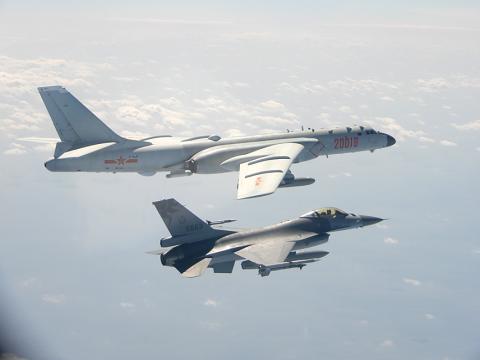The air force on Monday scrambled to warn off approaching Chinese jets, the first time they were spotted near Taiwan’s air space at night, the Ministry of National Defense said.
Taiwan has repeatedly said that China has stepped up its drills near the nation when it should be focusing its efforts on combating the spread of COVID-19.
An unspecified number of Chinese J-11 fighters and KJ-500 airborne early warning and control aircraft flew into the waters southwest of Taiwan for nighttime exercises, the ministry said late on Monday.

Photo: EPA-EFE
They came close to Taiwan’s air defense identification zone at about 7pm, ministry spokesman Major General Shih Shun-wen (史順文) said.
“After our air reconnaissance and patrol aircraft responded appropriately, and broadcast [an order] to drive them away, the [Chinese] communist aircraft flew away from our air defense identification zone,” he said.
The maneuvers were part of the Chinese squadron’s nighttime training mission, the ministry said.
The military keeps close watch on the Taiwan Strait and its environs to ensure the nation’s security, and people have no cause for alarm, it said.
The last time that the Chinese military conducted a similar mission near Taiwan’s airspace was on Feb. 28, when an unspecified number of Chinese H-6 bombers flew over the waters southwest of Taiwan, according to ministry records.
There was no immediate comment from China’s military on the latest drills.
China has been flying what it calls “island encirclement” drills on and off since 2016 when President Tsai Ing-wen (蔡英文) first took office.
The COVID-19 pandemic has worsened already poor relations between Taiwan and China, with the two sides accusing each other of spreading fake news, and Taiwan particularly angered by Beijing blocking its access to the WHO.

The Central Weather Administration (CWA) yesterday said it expected to issue a sea warning for Typhoon Fung-Wong tomorrow, which it said would possibly make landfall near central Taiwan. As of 2am yesterday, Fung-Wong was about 1,760km southeast of Oluanpi (鵝鑾鼻), Taiwan’s southernmost point, moving west-northwest at 26kph. It is forecast to reach Luzon in the northern Philippines by tomorrow, the CWA said. After entering the South China Sea, Typhoon Fung-Wong is likely to turn northward toward Taiwan, CWA forecaster Chang Chun-yao (張峻堯) said, adding that it would likely make landfall near central Taiwan. The CWA expects to issue a land

Taiwan’s exports soared to an all-time high of US$61.8 billion last month, surging 49.7 percent from a year earlier, as the global frenzy for artificial intelligence (AI) applications and new consumer electronics powered shipments of high-tech goods, the Ministry of Finance said yesterday. It was the first time exports had exceeded the US$60 billion mark, fueled by the global boom in AI development that has significantly boosted Taiwanese companies across the international supply chain, Department of Statistics Director-General Beatrice Tsai (蔡美娜) told a media briefing. “There is a consensus among major AI players that the upcycle is still in its early stage,”

The Central Weather Administration (CWA) yesterday said it is expected to issue a sea warning for Typhoon Fung-wong this afternoon and a land warning tomorrow. As of 1pm, the storm was about 1,070km southeast of Oluanpi (鵝鑾鼻), Taiwan’s southernmost point, and was moving west-northwest at 28 to 32kph, according to CWA data. The storm had a radius of 250km, with maximum sustained winds of 173kph and gusts reaching 209kph, the CWA added. The storm is forecast to pass near Luzon in the Philippines before entering the South China Sea and potentially turning northward toward Taiwan, the CWA said. CWA forecaster Chang Chun-yao (張峻堯) said

Japanese Prime Minister Sanae Takaichi yesterday said that China using armed force against Taiwan could constitute a "survival-threatening situation" for Japan, allowing the country to mobilize the Japanese armed forces under its security laws. Takaichi made the remarks during a parliamentary session while responding to a question about whether a "Taiwan contingency" involving a Chinese naval blockade would qualify as a "survival-threatening situation" for Japan, according to a report by Japan’s Asahi Shimbun. "If warships are used and other armed actions are involved, I believe this could constitute a survival-threatening situation," Takaichi was quoted as saying in the report. Under Japan’s security legislation,